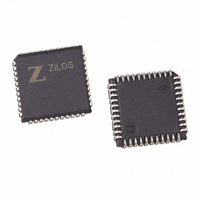Z8927320VSG Zilog, Z8927320VSG Datasheet - Page 40

Z8927320VSG
Manufacturer Part Number
Z8927320VSG
Description
DSP 20MHZ 16-BIT W/ A/D 44-PLCC
Manufacturer
Zilog
Series
Z892x3r
Type
Fixed Pointr
Datasheet
1.Z8937320FSC00TR.pdf
(60 pages)
Specifications of Z8927320VSG
Interface
SPI, 3-Wire Serial
Clock Rate
20MHz
Non-volatile Memory
OTP (16 kB)
On-chip Ram
1kB
Voltage - I/o
5.00V
Voltage - Core
5.00V
Operating Temperature
0°C ~ 70°C
Mounting Type
Surface Mount
Package / Case
44-LCC (J-Lead)
Lead Free Status / RoHS Status
Lead free / RoHS Compliant
Available stocks
Company
Part Number
Manufacturer
Quantity
Price
Company:
Part Number:
Z8927320VSG
Manufacturer:
Zilog
Quantity:
50
PERIPHERALS (Continued)
Z89223/273/323/373
16-Bit Digital Signal Processors with A/D Converter
Counter/Timers (C/T0 and C/T1)
The Z893x3 features two 16-bit Counter/Timers (C/T) that
can be independently configured to operate in various
modes. Each is implemented as a 16-bit Load Register and
a 16-bit down counter. Either C/T input can be selected from
UI0 or UI1. Either C/T output can be directed to TMO0 or
TMO1. The C/T clock is a scaled version of the system
clock. Each C/T features an 8-bit prescaler. The clock rates
of the two C/T are independent of each other. The C/Ts can
be programmed to recognize clock events on the rising
edge, the falling edge, or both rising and falling edges of
the input signal. Outputs on TMO0 or TMO1 can be pro-
grammed to occur with either polarity.
If either C/T is enabled and an output pin TMO0 or TMO1
is selected, and at the same time User Outputs are enabled,
the C/T takes precedence, and Status Register bits 5 or 6
do not affect the state of the selected pin.
C/T Modes of Operation:
MODE 0—Square Wave Output.
to generate a continuous square wave of 50% duty cycle.
Writing a new value to the TMLR Register takes effect at
the end of the current cycle, unless TMR is written.
MODE 1—Retriggerable One-Shot.
ured to generate a single pulse of programmable duration.
The pulse may be either logic High or logic Low. Retrig-
gering the one-shot before the end of the pulse causes it to
retrigger for a new duration.
MODE 2—8-Bit PWM.
a pulse-width modulated waveform. The duty cycle ranges
from 0–100% (0/256 to 255/256; 8-bits) of a cycle in steps
of 1/256 of a cycle. The asserted state of the waveform may
be either logic High or logic Low. Writing a new pulse-
width value to the TMLR Register takes effect at the end
of current cycle, unless TMR is written.
MODE 3—16-Bit PWM.
a pulse-width modulated waveform. The duty cycle ranges
40
System Clock
15
1
80h
Zeros
8 7
The C/T is configured to generate
Prescaler Value
The C/T is configured to generate
8-Bit Counter
TPLR
TPR
Figure 31. Counter/Timer 0 and 1 Block Diagram
The C/T is configured
0
The C/T is config-
2
UI1 UI0
MUX
TMCLKIN = System Clock
15
15
2 x (TPR + 1)
from 0–100% (0/65,536 to 65,535/65,536; 16-bits) of a cy-
cle in steps of 1/65,536 of a cycle. The asserted state of the
waveform may be either logic High or logic Low. Writing
a new pulse-width value to the TMLR Register takes effect
at the end of current cycle, unless TMR is written.
MODE 4—Finite Pulse String Generator.
configured to generate 1 to 65,535 pulses. The output pulses
are actually from the Timer Clock Prescaler divided by 2
(TMCLK). They are gated to the output until the Timer
Down-Counter underflows.
MODE 5—Externally Clocked One-Shot.
configured to generate an output pulse. The pulse may be
either logic High or logic Low. It is deasserted when a pro-
grammable number of input events (up to 65,535) occur on
the input pin, UI0 or UI1.
MODE 6—Software Watch-Dog Timer.
figured to generate a Hardware Reset on time-out, unless
retriggered by software.
MODE 7—Hardware Watch-Dog Timer.
figured to generate a Hardware Reset on time-out unless re-
triggered by an event on the input pin, UI0 or UI1.
MODE 8—Pulse Stopwatch.
measure the time during which its input is asserted.
MODE 9—Edge-to-Edge Stopwatch.
ured to measure the period from one rising (falling) edge
to the next rising (falling) edge on the input.
MODE 10—Edge Counter.
a number of input edges (up to 65,535). Input edges may
be selected as rising or falling or both.
MODE 11—Gated Edge Counter.
to count the number of input edges (up to 65,535) in a time
window set by the second timer. Edges are counted until the
second timer underflows. Input edges may be selected as
rising, falling, or both.
16-Bit Down Counter
Timer Load Register
TMLR
TMR
The C/T is configured to count
The C/T is configured to
TMCLKOUT = TMCLK
0
0
The C/T is configured
DS000202-DSP0599
The C/T is config-
MUX
The C/T is con-
The C/T is con-
T h e C / T i s
(TMR + 1)
T h e C / T i s
ZiLOG



















